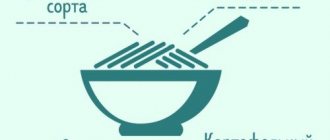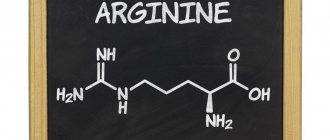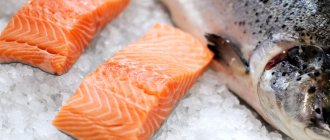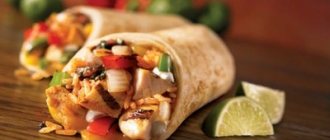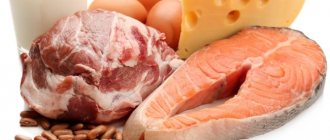Is it necessary to calculate nutritional and energy values?
The amount of kcal in a product is important information for consumers, which is why each manufacturer is obliged to accurately calculate all the calorie content of the product and indicate the information obtained on the packaging of the finished product.
According to the requirements of TR CU No. 022/2011 “Food products regarding their labeling,” information about calorie content must be indicated on the consumer packaging of any food product, which means that calculating the calorie content of dishes is a mandatory procedure for all food manufacturers.
Which food groups are the most and which are the least nutritious?
Products differ in energy value.
The calorie content of complex dishes or whole food depends on their composition, the choice of raw materials with lower or higher energy value, as well as on the technological processes or culinary processing methods used.
The most calorie-dense foods come from foods rich in fat, such as oil, and carbohydrates, such as refined sugar. The food group with the lowest calorie content is vegetables, and fruits, due to their higher sugar content, also have a higher energy value.
For example, one medium cucumber provides about 15 kcal, and one medium pear provides about 60 kcal. Fresh and frozen vegetables and fruits are generally low in calories. But dishes prepared from these products have a higher calorie content, since its growth is affected, for example, by the addition of sugar, butter or mayonnaise.
Alcoholic drinks also provide a significant amount of energy. They contain no fat and the sugar content, except in sweet wines and liqueurs, is negligible, although 1 g of pure ethanol provides up to 7 kcal.
Information about the energy content of a food product can be found on its packaging, usually in the nutritional value table. In contrast, the energy value of a meal or daily diet is calculated by adding up the energy value of the individual foods that make up your meal.
Who should carry out the calculation of nutritional and energy values?
The calculation of the calorie content of dishes should be carried out by a specialist who has all the necessary knowledge in the field of drawing up regulatory and technological documentation for food production. To calculate the nutritional and energy value, you must know exactly the energy coefficients of all types of substances and determine exactly what calorie content the dish will have, depending on the method of its preparation.
The single portal “One Window” specializes in the development and execution of all types of regulatory, technical and operational documentation for the production of products. The specialists of our portal will help you quickly obtain all the necessary documents, calculate the energy value and calorie content of products in order to comply with all legal regulations in the process of carrying out activities.
Where and how to order an energy value calculation?
Determination of calorie content is carried out by establishing the number of kilocalories in relation to each of the components contained in it (proteins, carbohydrates, fats) per 100 g of product. For this purpose, the following indicators are used:
- 1 g of protein contains 4 kcal;
- 1 g carbohydrates – 3.75 kcal;
- 1 g fat – 9 kcal.
To begin with, a specialist calculates the content of these substances in the product, and then, based on this information, determines the calorie content.
If you need to quickly calculate the energy value of a product, you should use the services of our Ros-Test Testing and Certification Center. Our staff consists of highly qualified employees who have the necessary knowledge and skills in the development of regulatory and technological documents.
The procedure for determining the calorie content of food products consists of the following steps:
- Appeals to consultants of the Ros-Test Testing and Certification Center.
- Customer Provision of Required Information – You will be required to provide information regarding the components used in the manufacturing process of the product.
- Carrying out all necessary calculations by our specialists using methods used in the industry.
- Obtaining an accurate calculation of energy and nutritional value.
What is needed to calculate the calorie content of foods?
To establish the nutritional and energy value, first of all, you should decide which indicator you need to obtain. Food manufacturers and managers of catering establishments often confuse them, passing them off as one another.
Nutritional value is a criterion characterizing the balance of a product. To determine it, information about the composition of the product is compared with the available standard nutritional values. The result is expressed as a percentage of a given norm. Energy value is the amount of energy that the human body receives when consuming certain products. Expressed in calories, kilocalories, joules.
Calculation of the energy value of products and food is carried out using the BZHU protocol, which indicates the amount of proteins, fats and carbohydrates in the product. The indicator is determined in one of the possible ways:
- Calculated. When applying this method, every ingredient that is included in the product is taken into account. Next, depending on the percentage, the required indicator for the hotel component is determined.
- Laboratory. The Kjeldahl method is used. Liquid chromatography or spectrophotometric techniques are also used. Each of the indicated options must be carried out in compliance with state standards.
When organizing laboratory tests, the following standards can be used:
- GOST 25001-2017;
- GOST 33409-2015.
Note! Calculating the nutritional value of food products is a mandatory step required to indicate information on the label of a product, on the menu or other sources. Displaying false data is prohibited by law. If such violations are discovered, the entrepreneur is held accountable under Article 14.8 of the Code of Administrative Offenses of the Russian Federation. When asking for help in determining the required indicators, an entrepreneur must provide a number of documents and information. Among them:
- registration certificates of an individual entrepreneur or company (copies of TIN, OGRN);
- a list of food products, dishes and other goods for which research needs to be conducted;
- information about the composition, raw materials used, technological process;
- information about the regulatory documents according to which the release of goods is organized.
The exact list of what is required for the procedure is determined individually during a preliminary consultation.
Basic indicators
Any food contains 3 main components: proteins, fats and carbohydrates. The amount of BJU for each product is indicated in grams. Nutrients are absorbed differently and differ in their energy value.
Squirrels
Protein is an organic compound made up of alpha amino acids. It performs an important construction function in the body. The human body contains 22 amino acids, 9 of which cannot be synthesized independently and come only from food.
Protein is present in all cells, tissues and organs; without it, the growth and development of the body is impossible.
Proteins keep the hormonal system in balance.
For the body to function properly, a person needs to consume protein in the right amount. Its functions:
- construction - is an integral part of all cells and tissues;
- enzymatic - accelerates the course of all chemical reactions;
- motor - ensures contraction of muscle fibers;
- transport - transports various macro- and microelements inside the body.
1 g of protein contains 4 kcal. These enzymes are absorbed by 92%. Protein-rich foods: beef, turkey, chicken breast, cottage cheese, eggs, tuna, almonds, liver, cheese, peas, etc.
Fats
Fats are organic substances that are the main structural and energy components of living organisms.
They perform the following functions:
- supply the body with essential fatty acids;
- are a source of energy;
- maintain hormonal balance;
- increase cell elasticity;
- help reduce dryness and flaking of the skin.
Fats are of plant and animal origin. 1 g of fat contains 9 kcal, which is 2 times more than proteins. Foods rich in fats: avocado, coconut, deep sea fish, oils, nuts, eggs, dairy products, etc.
Healthy fats in avocados.
Carbohydrates
Carbohydrates are organic substances that consist of carbon and water. They give a person energy for life and are found in many foods.
Carbohydrates are simple and complex. The first group is also called “fast”, they are easily digested and sharply increase blood sugar levels. The second - “long-lasting” carbohydrates - give a long-lasting feeling of satiety due to long-term absorption.
Functions of carbohydrates:
- structural - part of the structure of cell membranes, used to build ADP and ATP;
- energy - are a source of energy for all processes occurring in cells;
- protective - participate in the formation of immune cells;
- storage - accumulate in muscles and tissues in the form of glycogen.
1 g of carbohydrates provides 4 kcal of energy. Products rich in these substances: dried fruits, cereals, vegetables, fruits, pasta, mushrooms, cereal products.
Eggs and meat
These products are the main sources of animal protein.
Chicken and turkey meat are considered the lowest in calories - 100-120 kcal per 100 g. The fattest are duck and goose - 360-400 kcal. Of the other meat products, rabbit meat is the most nutritious - 180-200 kcal; pork is considered the most nutritious - 250-500 kcal. Lard has the highest nutritional value - 800 kcal per 100 g.
Of the eggs, chicken is considered the most common; its calorie content per 100 g is 157 kcal (white - 44 kcal, yolk - 354). Goose and duck eggs are more nutritious - 185 kcal per 100 g.
Milk
Dairy products are a source of protein.
In addition, they contain a lot of calcium. The calorie content of dairy products varies depending on their fat content. Milk 1.5% contains 45 kcal, and 3.2% - 60. Kefir can also be less or more fatty, its calorie content ranges from 31 to 59 kcal. The nutritional value of sour cream ranges from 114 to 300 kcal.
Cottage cheese has the same indicators. The calorie content of cheese ranges from 250 to 450 kcal. Yogurts can contain varying amounts of sugar and additives. Their calorie content starts at 60 kcal and can reach up to 150.
Fruits and berries
Fruits and berries should be included in your diet because they contain many vitamins and antioxidants.
Many of these foods are low in calories:
- oranges and tangerines - 40;
- apples, kiwis and pears - 47;
- melon - 35;
- watermelon - 27;
- peaches - 45;
- blackberries - 31;
- blueberry - 37.
Due to their higher sugar content, some fruits have higher calorie content:
- bananas - 89;
- grapes - 70;
- persimmon - 53;
- avocado - 170;
- mango - 65.

Grapes contain a lot of sugar.
Vegetables
Vegetables are a source of fiber, vitamins and minerals, many of them low in calories:
- eggplants and zucchini - 24;
- white cabbage - 28;
- colored - 30;
- carrots - 35;
- beets - 42;
- tomatoes - 24;
- cucumbers - 14;
- onions - 41.
However, there are also high-calorie vegetables, for example potatoes - 77 kcal per 100 g.
Cereals
Cereals are traditionally classified as complex carbohydrates.
They must be present in the diet. The calorie content of cereals ranges from 300-350 kcal:
- buckwheat - 330;
- rice - 320;
- Hercules - 350;
- barley - 322;
- wheat - 334;
- pearl barley - 324.
Bakery products
Products made from flour are higher in calories than the previously described products. Rye bread contains 210 kcal, a loaf - 260 kcal, bagels and crackers - 330 kcal, cream crackers - 400 kcal, and various types of baked goods - from 300 kcal and above.
Sausages
The energy value of sausages varies from 150 to 600 kcal, depending on the type of meat used in them. Boiled sausage has the lowest calorie content - 150-220 kcal. Sausages contain 220-350 kcal. Cooked and raw smoked sausage is the most high-calorie - from 450 to 600 kcal.

Elite sausages contain a large number of calories.
Oils
This category of products is the most high in calories due to the high fat content. Butter - 750 kcal, vegetable oils (sunflower, flaxseed, olive) - 900 kcal.
Nuts, seeds, dried fruits
This category of foods is rich in fats and vitamins.
The calorie content of nuts is quite high:
- peanuts - 555;
- walnuts - 662;
- cashews - 647;
- pistachios - 555;
- hazelnuts - 701.
Seeds have approximately 400-600 kcal per 100 g.
Dried fruits contain a lot of sugar, so their energy value increases compared to fruits:
- raisins - 273;
- prunes - 262;
- dried apricots - 270.
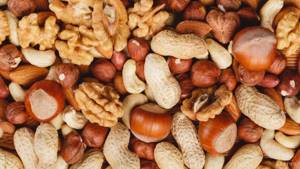
Calorie nuts and dried fruits.
Mushrooms
Mushrooms, like vegetables and fruits, are low in calories:
- champignons - 27;
- white - 25;
- boletus - 27;
- honey mushrooms - 25;
- saffron milk caps - 16.
Sweets (confectionery)
Sweets are a high-calorie product segment due to their high sugar content. The energy value of chocolate is 550 kcal, marshmallows and marshmallows - 300, cookies - 430, ice cream - from 150 to 250, waffles - 420, honey - 314.
Answers to popular questions
How much does it cost and what does the cost of calculating the nutritional value of a product depend on?
The exact cost of services for calculating the nutritional value of a product can be obtained from the portal specialists. Factors influencing the final price are:
- the number of products for which calculations will be carried out;
- composition of products and list of ingredients included in them;
- the applicant has accurate information about the quantitative content of proteins, fats and carbohydrates in the product;
- The type of determination of the required values used is calculated or laboratory.
- the need to prepare additional documents for the applicant.
How do you reduce the calorie content of foods?
Among food products there are many products with reduced energy value.
Their calorie content is reduced by reducing their fat and sugar content. Another way to reduce the calorie content of food is to replace sugar and fat with substances with low or no energy value.
For example, sugar can be replaced with polyol sweeteners (xylitol, maltitol), which have a lower calorie content than natural sugar (about 40%), or synthetic intense sweeteners (for example, aspartame, thaumatin), which have no calories. It should be noted that there are certain standards that regulate sweeteners, in what dose and in what products their use is allowed.
Low-calorie foods for weight loss
Eating healthy foods for weight loss will not only help you shed pounds, but will also provide many benefits to your body. Easily digestible protein, healthy fats, whole grains, vegetables and fruits - all this is a whole storehouse of useful elements. Simply eating more healthy foods is the start of your weight loss journey.
Celery
It is believed that celery is the very product that has a “negative” calorie content - in the process of digesting it, more calories are consumed than the body receives. Crispy celery stalks are full of antioxidants that actively fight harmful free radicals. This product also supports gastrointestinal health - it promotes efficient metabolism, which speeds up the process of weight loss. 100 grams of any part of celery contains 25 calories.
Apples
Apples are rich in antioxidants, which help cleanse the body of toxins that contribute to inflammation and unwanted weight gain. The large amount of fiber contained in this fruit also activates metabolism. An eaten apple can satisfy hunger, making a person feel full faster and eat less during the day, and fiber helps keep the microbiome in the intestines healthy and balanced, which is an important condition for good metabolism. 100 grams of apples contain 52 calories.
Sour cabbage
As a light snack or as a side salad, you can use sauerkraut, which is so good for the intestines. Adding this product to your diet promotes weight loss due to accelerated metabolism. There are 20 calories in 100 grams of sauerkraut.
Chia seeds
Just one serving (two tablespoons) of chia seeds contains 10 grams of fiber—40% of the recommended daily intake. The fiber in the seeds helps you feel full faster and prevent you from overeating. By the way, chia seeds expand in water, so you can eat a small amount of the product. This low-calorie ingredient is perfect for making smoothies, yogurt, and pudding. Dry seeds contain 512 calories.
Oatmeal
In addition to the 4 grams of fiber contained in a glass of oatmeal, oatmeal boasts the same amount of protein as a chicken egg. A popular breakfast food like oatmeal with water or milk is an excellent low-calorie option for weight loss. For variety, you can add fresh berries (strawberries, raspberries, currants) and chia seeds to the porridge. You should not add sugar, syrup or honey - these products are high in calories. Also, avoid eating instant oatmeal as it contains hidden sweeteners. Dry oatmeal contains 318 calories per 100 grams, and porridge with water contains 88 calories.
These products are most often found in the diets of weight loss adherents and those who are simply trying to eat healthy. In addition to these dishes, the list goes on for a long time: seaweed (5 calories), cucumbers and tomatoes (13 and 20 calories, respectively), broccoli (33 calories), grapefruit (43 calories), cod (78 calories), hake ( 95 calories).
Calorie intake for men and women
There is a norm of calorie consumption, the calculation of which takes into account gender, age, and physical activity. So, according to generally accepted data, the daily calorie intake for men is from 2000 to 2500, depending on age. Men leading an active lifestyle can easily eat 2700 calories, but the menu for athletic people should be in the range of 2800-3000 kcal.
For women, the calorie intake rate is different. So, girls can eat within the range of 1800-2000 calories, older women - up to 1700 kcal. Representatives of the fair sex who lead an active lifestyle should create a menu so that it fits in 2200-2400 calories. For female athletes, the diet is limited to 2300-2500 calories.
The Best Foods for Mass Gain
There are often cases when people do not want to lose weight, but to gain weight. It is important to approach this idea wisely: limit your fat intake and add protein. But which foods help you gain muscle the most?
Chicken breast
Is there any other food more associated with bodybuilding and bulking than chicken breast? Economical and easy to prepare, packed with plenty of protein, it is an ideal muscle-building food. 100 grams of chicken breast contains as much as 32 grams of protein, and the energy value of the food product is 165 calories.
Pumpkin seeds
Pumpkin seeds are a complete source of protein. Fatty acids, contained in large quantities in this product, also improve cellular activity, naturally affecting the normal functioning of all organs and systems of the body. 100 g of seeds contain 30 g of protein, but the caloric content of this product is high - 450 calories per serving.
Wild salmon meat
Farmed fish differs from wild fish not only in color (real meat is red, not gray), but also in the amount of nutrients. So, during small-scale breeding, the fish are fed with concentrates from bone meal and fish oil, antibiotics, hormones, and that is why farmed fish are large and aggressive. It is important to consume wild salmon meat - it contains complete protein and powerful antioxidants, omega-3 fatty amino acids. Interesting fact: a laboratory experiment on mice showed that consuming a large amount of omega in the diet helps to increase life expectancy. As for useful components, 100 g of wild salmon meat contains 25 grams of protein; in a raw product - 140 calories, in a steak - 200.
Chicken eggs
One egg contains 6 g of protein, as well as large amounts of zinc and healthy fats. It is best to eat brown eggs rather than white ones - they contain more nutrients. By the way, it is important to eat homemade eggs - they differ from store-bought eggs in their bright yolk and higher energy value. 100 g of eggs contain 13 g of protein; calorie content of the boiled product is 155 kcal per serving.
Soybeans, Greek yogurt and chickpeas
Soybeans actively support cardiovascular health. It is best to consume fermented or sprouted soybeans to avoid processed foods. One serving (100 grams) contains 13 grams of protein. The calorie content of dry beans is 450 calories, boiled with salt – 140 calories.
Low in carbohydrates, Greek yogurt is an ideal evening snack and muscle-building snack. 100 g of yogurt contains 10 g of protein and 60 calories.
Chickpeas can also be used as a side dish - they contain easily digestible protein, B vitamins, potassium, calcium and magnesium. One boiled serving contains 19 grams of protein and 127 calories.
Common foods for weight gain also include other types of fish (tuna, cod), whole milk and fermented milk products, and lean meat. This small list of protein-rich foods will help you gain weight and get ripped. However, any food with a high protein content and low fat content is suitable for those who are actively involved in sports and want to achieve a toned figure.
